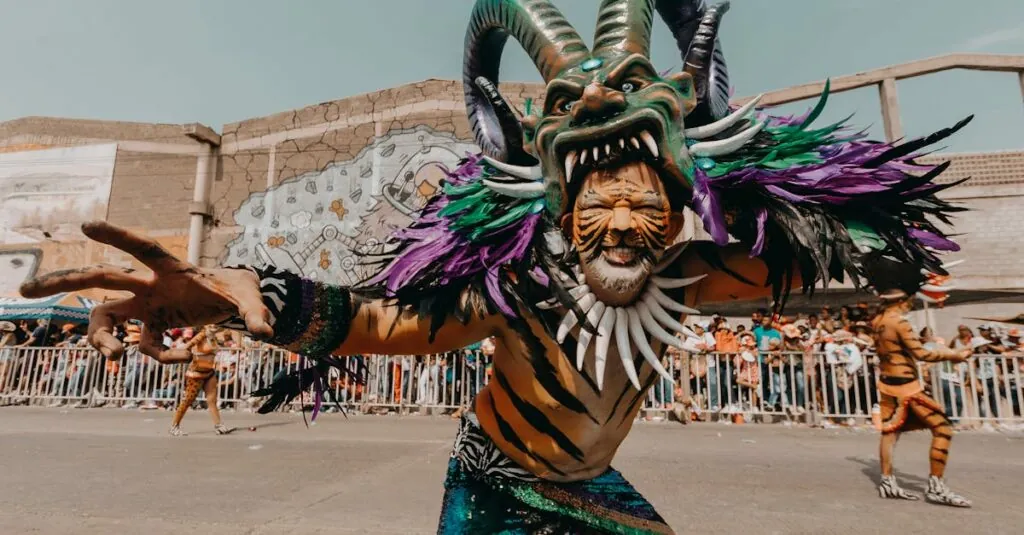Table of Contents
ToggleThe Dominican Republic isn’t just a tropical paradise; it’s a vibrant tapestry of culture that’ll make anyone want to dance the merengue. From the lively streets of Santo Domingo to the stunning beaches of Punta Cana, this Caribbean gem is bursting with history, music, and flavors that’ll tickle the taste buds.
Overview of Dominican Republic Culture
Dominican Republic culture showcases a blend of indigenous Taíno, African, and European influences. This mix is evident in the country’s music, dance, and festivals. Merengue and bachata represent the nation’s signature music genres, with vibrant rhythms inviting everyone to dance. Traditional folk music reflects the diverse history and cultural tapestry.
Cuisine plays a central role in daily life. Dishes like sancocho, mangu, and mofongo illustrate the rich flavors and culinary traditions. Local ingredients such as rice, beans, and plantains dominate many meals, highlighting the agricultural bounty of the region. Many restaurants offer fresh seafood reflecting the nation’s coastal geography.
Art and craft thrive within communities, showcasing creativity and heritage. Handcrafted items, including jewelry and paintings, often tell stories of local traditions. Festivals, like the Carnival, celebrate cultural expressions through colorful parades, elaborate costumes, and lively performances. Participants display pride in their cultural identity during these events.
Religious beliefs also influence the culture. Predominantly Roman Catholic, many Dominicans celebrate both religious and secular holidays. The Día de los Reyes Magos, for example, illustrates the blend of cultural celebration and spirituality. This deep connection to faith and tradition enhances community bonds.
Language acts as another crucial cultural component. Spanish serves as the official language, incorporating local phrases and expressions unique to the island. This linguistic heritage promotes a sense of belonging among residents. Overall, the combination of music, cuisine, art, festivals, religion, and language creates a vibrant and unified Dominican Republic culture, captivating visitors and residents alike.
Historical Influences
Historical influences shape the vibrant culture of the Dominican Republic in profound ways. These influences include indigenous roots and colonial legacy.
Indigenous Roots
The indigenous Taíno people significantly contributed to the cultural landscape. Their traditions, customs, and agricultural practices laid foundational aspects. Words and food from the Taíno remain integral, with items like cassava and guava appearing in local cuisine. Additionally, Taíno spirituality and beliefs continue to influence cultural expressions. Festivals often honor Taíno heritage, showcasing traditional rituals and practices. Exploration of this cultural tapestry reveals a rich blend of past and present.
Colonial Legacy
Spanish colonization transformed the island’s cultural identity. The arrival of Europeans in the late 15th century ushered in new customs, languages, and religions. Spanish architecture, evident in Santo Domingo’s historic sites, reflects colonial influence. Culinary practices evolved as African ingredients blended with European techniques. The legacy of colonization is also evident in the predominant Roman Catholic faith, which shaped social values and holidays. Notably, the fusion of various cultural elements created a unique identity that persists today.
Language and Communication
Language plays a vital role in the Dominican Republic’s culture. Spanish serves as the official language, embodying local nuances and expressions that reflect the nation’s identity.
Spanish Language
Spanish dominates daily communication, with approximately 10 million speakers. Local dialects incorporate words from indigenous Taíno and African languages, enhancing the richness of conversations. For example, unique phrases and slang reflect daily life and cultural influences. Heavily influenced by various regions, the language develops distinct accents, adding to its charm. Education systems prioritize Spanish, ensuring proficiency across generations. This linguistic unity fosters connections among Dominicans, creating a sense of community.
Cultural Expressions
Communication extends beyond spoken language through various cultural expressions. Visual arts, including paintings and crafts, depict historical and cultural narratives. Festivals serve as vibrant platforms for expressing local identity, featuring traditional dances and music. Merengue and bachata, signature dance styles, represent emotional storytelling through rhythm. Additionally, community gatherings promote shared experiences, strengthening societal bonds. Foods like sancocho and mangu often narrate familial traditions, enriching conversations at mealtime. Everywhere, the blending of languages and cultural expressions creates a colorful tapestry that characterizes Dominican life.
Music and Dance
Music and dance play a pivotal role in the Dominican Republic’s cultural landscape. The country’s vibrant traditions echo through its signature musical styles, merengue and bachata.
Merengue and Bachata
Merengue stands as the national dance of the Dominican Republic. Its lively rhythm captivates and invites everyone to join in. Bachata, another beloved genre, reflects themes of love and heartbreak. Originating in rural communities, the dance has evolved, blending modern influences while retaining traditional roots. Both genres thrive in dance halls, festivals, and social gatherings, showcasing the Dominican passion for music. Notably, merengue gained international recognition, while bachata has increasingly gained global popularity.
Traditional Instruments
Traditional instruments enrich the Dominican music scene. The accordion often accompanies merengue, adding a distinct sound. Bajo eléctrico grounds bachata with its deep bass tones. Other popular instruments include tambora and güira, which maintain rhythmic integrity. These elements create a unique auditory experience that defines the nation’s musical identity. Folk music, featuring these instruments, also plays a vital role in preserving cultural stories. In essence, the combination of these instruments enhances the cultural tapestry, creating an engaging atmosphere for all.
Culinary Traditions
Culinary traditions in the Dominican Republic reflect a rich tapestry of cultural influences. The blending of indigenous Taíno, African, and European flavors creates a unique gastronomic experience.
Popular Dishes
Sancocho stands out as a hearty stew enjoyed during festive occasions. Mangu, made from mashed plantains, serves as a popular breakfast dish accompanied by fried eggs and cheese. Mofongo, a dish of fried plantains filled with garlic and chicharrón, captivates diners with its bold flavors. To satisfy sweet cravings, tembleque—a coconut pudding—delights locals and visitors alike. Each plate showcases the country’s culinary creativity and deep-rooted traditions.
Culinary Ingredients
Rice, beans, and plantains serve as staple ingredients in Dominican cuisine. The vibrant use of spices like oregano, garlic, and cilantro adds depth to dishes. Tropical fruits enhance the menu, with mangoes, guavas, and papayas appearing frequently in meals and desserts. Fresh seafood from the Caribbean waters features prominently, enriching the coastal culinary scene. Together, these ingredients reflect the island’s agricultural bounty and diverse cultural heritage.
Art and Literature
Art and literature in the Dominican Republic reflect the country’s diverse cultural heritage. Both forms of expression celebrate the island’s history and identity.
Visual Arts
Visual arts encompass a variety of mediums, showcasing the creativity of Dominican artisans. Painters like Clara Ledesma capture the vibrancy of everyday life through their works. Traditional crafts such as pottery and weaving continue to thrive, often incorporating indigenous designs. Artists often depict themes rooted in the nation’s folklore, while contemporary artists explore modern issues and trends. Cultural institutions, like the Museum of Modern Art in Santo Domingo, promote these artistic expressions by hosting exhibitions and events that highlight local talent and foster appreciation among the community.
Notable Authors
Notable authors from the Dominican Republic contribute significantly to Latin American literature. Junot Díaz, a Pulitzer Prize-winning writer, explores identity and migration in his narratives. Julia de Burgos, a celebrated poet, infuses her works with themes of love and social justice. Other prominent figures include Juan Bosch, who penned novels and stories that reflect the country’s political landscape. These authors often draw inspiration from their culture, weaving rich narratives that resonate with both local and international readers, enhancing the literary scene of the Dominican Republic.
The Dominican Republic’s culture is a vibrant tapestry woven from its rich history and diverse influences. From the lively rhythms of merengue and bachata to the mouthwatering flavors of traditional dishes, every aspect reflects a unique blend of heritage. The warmth of the people and their traditions creates an inviting atmosphere that resonates with both locals and visitors.
Art and literature further enrich the cultural landscape, offering insights into the nation’s identity and experiences. Festivals and celebrations showcase the community’s spirit, fostering connections through shared joy and creativity. This dynamic cultural environment makes the Dominican Republic a captivating destination for anyone looking to explore its heritage and traditions.




